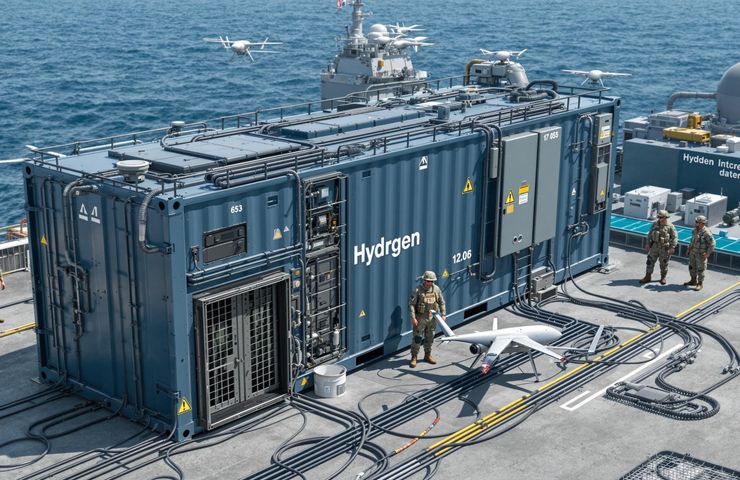
Hydrogen Production Goes Tactical: DoD Deploys EHOSS for Energy Autonomy
July 31, 2025The U.S. Department of Defense is tapping into hydrogen production to power the next wave of military tech, kicking things off with a bold new prototype: the Expeditionary Hydrogen On Ship and Shore (EHOSS). Think of it as a portable, modular hydrogen fueling station that can go wherever the action is—from warships to remote outposts, even in contested zones where traditional fuel chains just don’t cut it.
EHOSS: Portable Power With a Punch
Slated to be field-ready by July 2025, the EHOSS unit is engineered to generate more than 20 kilograms of clean, high-purity hydrogen each day at 350 bar pressure through commercial PEM electrolysis systems. Developed by Pratt Miller (a part of Oshkosh Corporation) under a contract with the Defense Innovation Unit (DIU), this system is designed from the ground up to be agile, shippable, and mission-ready—on land or sea.
Picture a hydrogen microgrid in a box—compact, rugged, and ready to fuel anything from surveillance balloons and unmanned ground vehicles to portable power systems. Its smart design even includes adaptable power modules, so it can run on whatever power you’ve got—AC, DC, or whatever else the field throws your way.
Redefining the Military’s Energy Playbook
This isn’t just about switching fuels—it’s a bigger rethink of how the Pentagon powers its operations. Relying on convoys to haul fuel across tough terrain or dangerous zones has always carried huge risks. EHOSS takes that vulnerability off the table by letting troops make hydrogen on-site. That means safer missions, faster movement, and a major step toward green hydrogen solutions that align with broader sustainable energy goals.
As one senior DoD energy expert put it: “This isn’t just about cutting fuel costs—it’s about mobility, survivability, and staying five steps ahead.” EHOSS ties directly into newer military strategies like distributed maritime operations and expeditionary advanced basing, which are especially relevant in places like the Indo-Pacific where just getting fuel from point A to B can be a logistical nightmare.
Built on Collaboration
EHOSS isn’t a one-team show. It’s the product of coordinated efforts across multiple defense branches and research hubs—from the U.S. Marine Corps Expeditionary Energy Office to the Naval Research Laboratory, Naval Undersea Warfare Command, Army Ground Vehicle Systems Center, and Naval Information Warfare Center Pacific. Each team brings deep, specialized knowledge—whether it’s underwater tech, mobile power, or remote surveillance.
This cross-agency teamwork signals a bigger shift: energy is no longer the backdrop—it’s become a core capability across the military.
Immediate Wins, Future Potential
Right out of the gate, EHOSS cuts down risk. Less fuel hauling means fewer targets, and the low heat and noise signatures make it ideal for stealth missions. Long-term? It paves the way for a shift toward zero-emission technology in the field—plus, it could spill over into disaster zones, off-grid scientific outposts, or even remote Arctic operations.
Of course, it’s not without its challenges. Hydrogen infrastructure always comes with safety concerns, especially when dealing with varying power sources in harsh environments. But since EHOSS is built with a lot of commercial-off-the-shelf (COTS) components, upgrades and improvements can roll out quickly—no need to start from scratch each time.
Bigger Than the Battlefield
Why does this matter? Because when the Department of Defense places a bet, industries take notice. EHOSS is more than a fuel solution—it’s a future model for resilient, clean, and agile energy systems. And its potential stretches well beyond the military: emergency response, wilderness medicine, and decentralized industrial energy are just a few sectors that could benefit.
Testing is already underway, with full deployment on the horizon for mid-2025. If all goes well, EHOSS might just rewrite the playbook for fuel cell technology and portable hydrogen infrastructure in both military and civilian domains.
What Comes Next?
If EHOSS hits its marks, it could set the standard for how we use green hydrogen to power operations in the toughest environments on Earth. The only question left: how fast can we scale it?



 With over 15 years of reporting hydrogen news, we are your premier source for the latest updates and insights in hydrogen and renewable energy.
With over 15 years of reporting hydrogen news, we are your premier source for the latest updates and insights in hydrogen and renewable energy.
good idea…..but how be sure that electrical energy and water are available to produce hydrogen on site? it seems to me that bringing diesel fuel where needed is still the easiest way …….